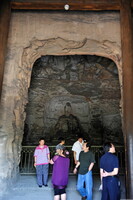| dc.coverage.spatial | Site: Yungang Grottoes (Datong, Shanxi, China) | en_US |
| dc.coverage.temporal | ca. 471-494 (creation) | en_US |
| dc.creator | unknown (Chinese) | en_US |
| dc.date | 471-494 | en_US |
| dc.date.accessioned | 2013-08-15T14:23:36Z | |
| dc.date.available | 2013-08-15T14:23:36Z | |
| dc.date.issued | 471-494 | en_US |
| dc.identifier | 230065 | en_US |
| dc.identifier.other | archrefid: 2362 | en_US |
| dc.identifier.uri | http://hdl.handle.net/1721.3/137849 | |
| dc.description | Cave 8 exterior, looking through wood door jamb into cave; The Yungang Grottoes are located 16 km west of Datong and comprise about 53 caves and 51,000 statues. The site stretches about 1 kilometer from east to west and was hollowed from the sandstone cliffs of the Wuzhou Mountains during the 5th century CE under the patronage of the Northern Wei dynasty. Founded by the Tuoba or Toba people, who ruled northern China during the Northern and Southern Dynasties period (310-589 CE), the Wei dynasty adopted Buddhism as its state religion. Work was begun at Yungang by the emperor Wenchengdi (reigned 452-465). The caves range in width from 23 m to a few metres. In 494, the Wei moved their capital from Datong to Luoyang and the Yungang Grottoes slowly fell into decay. The Grottoes have been a UNESCO World Heritage site since 2001. Caves 7-12, which seem to be grouped in pairs, show a more regular plan than the Tanyao Caves. Rectangular, they are divided into front and rear chapels. The main image is accompanied by representations of bodhisattvas, triads of the Buddha, flying apsarasas (heavenly beings), heavenly musicians, jātakas (stories from the life of the historical Buddha) and ornamental reliefs covering the walls, ceilings and entrance. Source: Grove Art Online; http://www.oxfordartonline.com/ (accessed 5/9/2011) | en_US |
| dc.format.medium | sandstone; polychrome (mineral pigment paint) | en_US |
| dc.rights | © Scott Gilchrist, Archivision, Inc. | en_US |
| dc.subject | architecture | en_US |
| dc.subject | decorative arts | en_US |
| dc.subject | deities | en_US |
| dc.subject | Buddhism and art--China | en_US |
| dc.subject | Silk Road | en_US |
| dc.subject | Buddhist cave art | en_US |
| dc.subject | Chinese | en_US |
| dc.subject | Northern Wei | en_US |
| dc.title | Yungang Grottoes: Cave 8 | en_US |
| dc.title.alternative | 云冈石窟 | en_US |
| dc.type | image | en_US |
| dc.rights.access | Licensed for educational and research use by the MIT community only | en_US |
| dc.identifier.vendorcode | 1A2-CH-D-YG-8-A5 | en_US |
| vra.culturalContext | Chinese | en_US |
| vra.technique | carving (processes), painting and painting techniques | en_US |
| vra.worktype | sculpture (visual work) | en_US |
| vra.worktype | shrine (structure) | en_US |
| vra.worktype | relief (sculpture) | en_US |
| dc.contributor.display | unknown (Chinese) | en_US |


